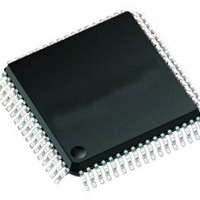PIC24FJ64GA110-E/PT Microchip Technology, PIC24FJ64GA110-E/PT Datasheet - Page 129

PIC24FJ64GA110-E/PT
Manufacturer Part Number
PIC24FJ64GA110-E/PT
Description
16-bit, 16 MIPS, 64KB Flash, 16Kb RAM, 84 I/O, NanoWatt 100 TQFP 12x12x1mm TRAY
Manufacturer
Microchip Technology
Series
PIC® 24Fr
Datasheet
1.PIC24FJ128GA106-IPT.pdf
(330 pages)
Specifications of PIC24FJ64GA110-E/PT
Core Processor
PIC
Core Size
16-Bit
Speed
32MHz
Connectivity
I²C, IrDA, LIN, SPI, UART/USART
Peripherals
Brown-out Detect/Reset, LVD, POR, PWM, WDT
Number Of I /o
85
Program Memory Size
64KB (22K x 24)
Program Memory Type
FLASH
Ram Size
16K x 8
Voltage - Supply (vcc/vdd)
2 V ~ 3.6 V
Data Converters
A/D 16x10b
Oscillator Type
Internal
Operating Temperature
-40°C ~ 125°C
Package / Case
*
Processor Series
PIC24FJ256GA110
Core
PIC
Data Bus Width
16 bit
Data Ram Size
16 KB
Interface Type
UART, I2C, SPI
Maximum Clock Frequency
8 MHz
Number Of Timers
5
Operating Supply Voltage
3.6 V
Maximum Operating Temperature
- 40 C to + 85 C
Mounting Style
SMD/SMT
Lead Free Status / RoHS Status
Lead free / RoHS Compliant
Eeprom Size
-
Lead Free Status / Rohs Status
Details
Available stocks
Company
Part Number
Manufacturer
Quantity
Price
Company:
Part Number:
PIC24FJ64GA110-E/PT
Manufacturer:
Microchip Technology
Quantity:
10 000
- Current page: 129 of 330
- Download datasheet (3Mb)
10.3
The input change notification function of the I/O ports
allows the PIC24FJ256GA110 family of devices to gen-
erate interrupt requests to the processor in response to
a change of state on selected input pins. This feature is
capable of detecting input change of states even in
Sleep mode, when the clocks are disabled. Depending
on the device pin count, there are up to 81 external
inputs that may be selected (enabled) for generating an
interrupt request on a change of state.
Registers, CNEN1 through CNEN6, contain the
interrupt enable control bits for each of the CN input
pins. Setting any of these bits enables a CN interrupt
for the corresponding pins.
Each CN pin has both a weak pull-up and a weak
pull-down connected to it. The pull-up acts as a current
source that is connected to the pin, while the pull-down
acts as a current sink that is connected to the pin.
These eliminate the need for external resistors when
push button or keypad devices are connected. The
pull-ups and pull-downs are separately enabled using
the CNPU1 through CNPU6 registers (for pull-ups) and
the CNPD1 through CNPD6 registers (for pull-downs).
Each CN pin has individual control bits for its pull-up
and pull-down. Setting a control bit enables the weak
pull-up or pull-down for the corresponding pin.
When the internal pull-up is selected, the pin pulls up to
V
external pull-up source when the internal pull-ups are
enabled, as the voltage difference can cause a current
path.
2010 Microchip Technology Inc.
DD
Note:
– 0.7V (typical). Make certain that there is no
Input Change Notification
Pull-ups on change notification pins
should always be disabled whenever the
port pin is configured as a digital output.
PIC24FJ256GA110 FAMILY
10.4
A major challenge in general purpose devices is provid-
ing the largest possible set of peripheral features while
minimizing the conflict of features on I/O pins. In an
application that needs to use more than one peripheral
multiplexed on a single pin, inconvenient workarounds
in application code or a complete redesign may be the
only option.
The Peripheral Pin Select feature provides an alternative
to these choices by enabling the user’s peripheral set
selection and their placement on a wide range of I/O
pins. By increasing the pinout options available on a par-
ticular device, users can better tailor the microcontroller
to their entire application, rather than trimming the
application to fit the device.
The Peripheral Pin Select feature operates over a fixed
subset of digital I/O pins. Users may independently
map the input and/or output of any one of many digital
peripherals to any one of these I/O pins. Peripheral Pin
Select is performed in software and generally does not
require the device to be reprogrammed. Hardware
safeguards are included that prevent accidental or
spurious changes to the peripheral mapping once it has
been established.
10.4.1
The Peripheral Pin Select feature is used with a range
of up to 46 pins, depending on the particular device and
its pin count. Pins that support the Peripheral Pin
Select feature include the designation “RPn” or “RPIn”
in their full pin designation, where “n” is the remappable
pin number. “RP” is used to designate pins that support
both remappable input and output functions, while
“RPI” indicates pins that support remappable input
functions only.
PIC24FJ256GA110 family devices support a larger
number of remappable input only pins than remappable
input/output pins. In this device family, there are up to
32 remappable input/output pins, depending on the pin
count of the particular device selected; these are num-
bered, RP0 through RP31. Remappable input only pins
are numbered above this range, from RPI32 to RPI45
(or the upper limit for that particular device).
See
package offering.
Table 1-4
Peripheral Pin Select
AVAILABLE PINS
for a summary of pinout options in each
DS39905E-page 129
Related parts for PIC24FJ64GA110-E/PT
Image
Part Number
Description
Manufacturer
Datasheet
Request
R

Part Number:
Description:
Manufacturer:
Microchip Technology Inc.
Datasheet:

Part Number:
Description:
Manufacturer:
Microchip Technology Inc.
Datasheet:

Part Number:
Description:
Manufacturer:
Microchip Technology Inc.
Datasheet:

Part Number:
Description:
Manufacturer:
Microchip Technology Inc.
Datasheet:

Part Number:
Description:
Manufacturer:
Microchip Technology Inc.
Datasheet:

Part Number:
Description:
Manufacturer:
Microchip Technology Inc.
Datasheet:

Part Number:
Description:
Manufacturer:
Microchip Technology Inc.
Datasheet:

Part Number:
Description:
Manufacturer:
Microchip Technology Inc.
Datasheet:











